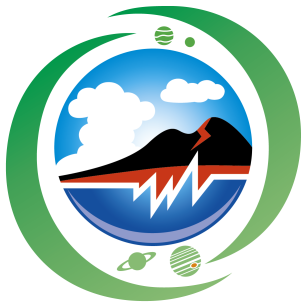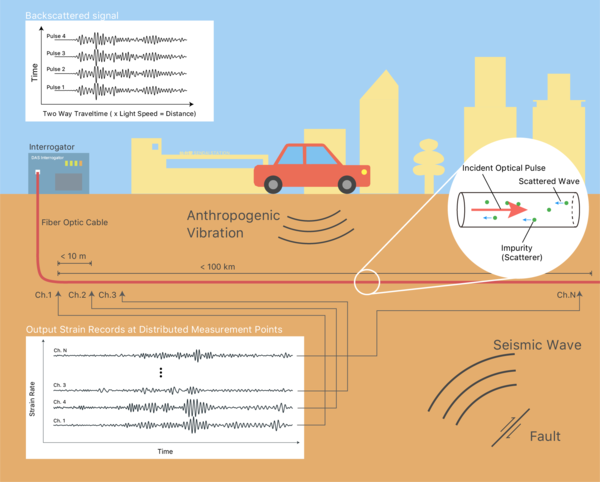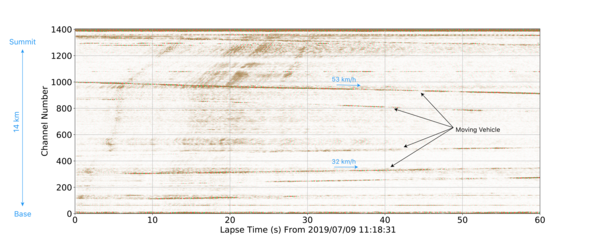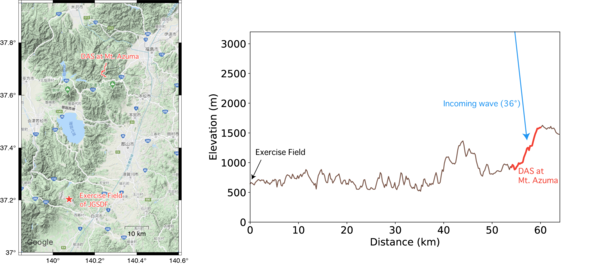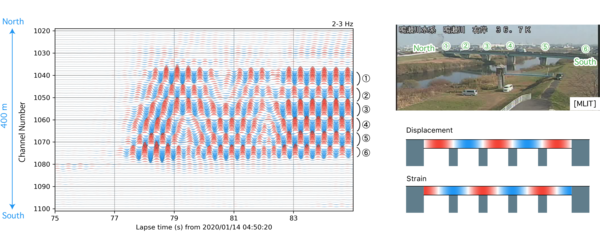Topics 2021.05.24
Measurement of the vibration using the optical fiber cable
Fiber optic cables located around the world make high-speed communication possible. In the seismological community, these fiber optic cables are used for the measurement of the vibration of the earth in these years. This method is called Distributed Acoustic Sensing (DAS). The optical pulse emitted from an interrogator is scattered by the subtle impurity in the optical fiber and the backscattered light is recorded at the interrogator. When some vibration is applied to a certain point of the fiber, the backscattered signal corresponding to that location is slightly changed. From the analysis of that change, we can observe the strain at that point. Using this technique, the time series of the strain at every few meters along the cable up to 100 km can be measured. The DAS technique greatly improves the spatial resolution of the seismic observation compared to the conventional observation using seismometers. All we need is to connect an interrogator unit at one end of the pre-existing telecommunication fiber optic cable. So, the DAS measurement is a cost-efficient method although the measurement position is restricted to the fiber location.
Figure 1. Concept of DAS observation. Analyzing the backscattered signal of the input optical pulse, the strain can be measured at a certain location along the fiber optic cable. Since the measurable points are distributed over the entire cable, this technique is called "Distributed" Acoustic Sensing. We can measure the ground motion by using the buried fiber optic cable.
We have conducted two DAS observations at Azuma volcano (Fukushima Pref.) and along the National Route 4 in Miyagi Pref. in collaboration with Research Center for Prediction of Earthquakes and Volcanic Eruptions. At Azuma volcano, we have succeeded to obtain the high spatial resolution wavefield of volcanic earthquakes and determined their hypocenters [Nishimura et al., 2021]. In addition to natural earthquakes, anthropogenic signals are also recorded by the DAS observation, because these fiber optic cables are deployed at a shallow depth along the road. This time, we introduce such signals other than natural earthquakes.
Figure 2 shows an example of a 1-minute strain rate record observed along the Bandai-Azuma Skyline at Azuma volcano. Signals generated by vehicles are clearly recorded as near-horizontal lines. The DAS can be used for the monitoring of traffic like this. In this example record, we can also see the wave train propagating from the south to the north with the apparent propagation velocity of 420 m/s. At first, we couldn't find the origin of this signal as no earthquake occurred at this timing. But finally found that Japan Ground Self-Defense Force carried out the exercise of cannon shooting in that day at their exercise field located about 60 km south of the Azuma volcano. We conclude that the infrasound generated by the exercise was detected by the DAS at Azuma volcano (Figure 3). The higher apparent velocity compared to the speed of sound indicates that the incident angle of the acoustic wave is 36 degrees from the ground.
Figure 2. Example of a 1-minute strain rate records observed by the DAS experiment at Azuma volcano. The polarity of the strain rate is colored in green and red. Several near-horizontal lines correspond to the signals of moving vehicles. The wave train propagating from the south to the north is recorded between 0 to 30 s.
Figure 3. (Left) Map of locations of the Mt. Azuma and the exercise field of Japan Ground Self-Defense Force. (Right) Topography between the exercise field and Mt. Azuma. The vertical scale is enlarged.
Next, we introduce the vibration record by the DAS along National Route 4. We installed the interrogator in Furukawa and record the strain rate every 5 m along the road down south to Sendai. The total length of the cable is 50 km. The data volume is almost 1 TB per day. Figure 4 shows the 10 s strain rate record around the Sanbongi bridge spanning the Naruse river in Osaki city. When a vehicle reaches the edge of the bridge, the vibration propagates to the whole bridge. This shaking lasts for several tens of seconds. After several seconds from the generation of the vibration, we can see the spatio-temporal pattern of the standing wave. Owing to the high spatial resolution of the DAS measurements, we can obtain this kind of small-scale phenomenon. We found a negative correlation between the eigen frequency of the bridge and the temperature. This may be caused by the thermal expansion and contraction of the bridge. In this way, DAS can be used for the monitoring of the infrastructure.
Figure 4. Strain rate record around Sanbongi bridge. The vibration generated at 77 s is spread over the entire bridge. The standing wave is gradually formed. The strain is the spatial derivative of the displacement, so the large amplitudes are observed at piers.
Seismometers are installed in the quiet area to avoid anthropogenic noise in general. However, fiber optic cables are deployed in the urban area because of its nature of telecommunication. Therefore, efficient methods to retrieve the meaning signal from the vast amount of DAS data are required. Moreover, the output signal of the DAS is the strain or strain rate spatial derivative of the displacement or velocity recorded by using ordinary seismometers. So, the development of analysis methods that can be applied to the strain is also required to make the most of the characteristics of the strain. The DAS measurement will become one of the standard observation tools soon. It will be interesting to see the results of future studies using the DAS.
Kentaro Emoto (Assistant Professor, Solid Earth Physics Laboratory)
Acknowledgement
DAS observations were supported by Fukushima and Sendai Office of River and National Highway, Tohoku Regional Bureau, Ministry of Land, Infrastructure, Transport and Tourism.
Reference
Nishimura, T., Emoto, K., Nakahara, H. et al. Source location of volcanic earthquakes and subsurface characterization using fiber-optic cable and distributed acoustic sensing system. Sci Rep 11, 6319 (2021). https://doi.org/10.1038/s41598-021-85621-8
